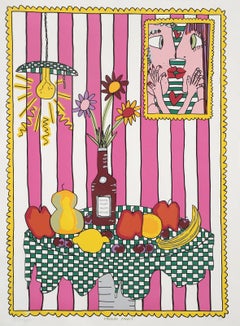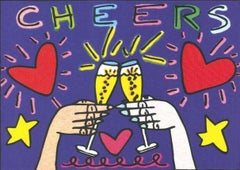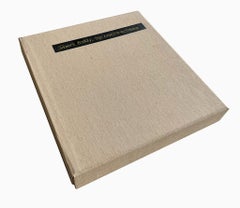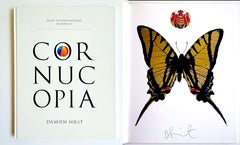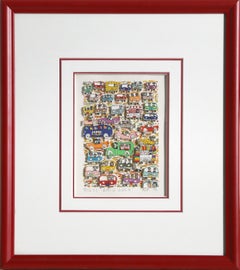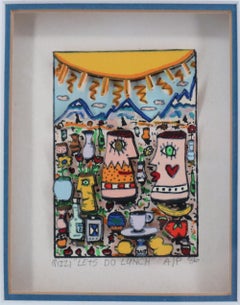James Rizzi Prints and Multiples
American, 1950-2011
James Rizzi (October 5, 1950 – December 26, 2011) was an American pop artist who was born and raised in Brooklyn, New York. Rizzi was most famous for his 3D artwork, "especially the large, elaborate prints and teeming anthropomorphic cityscapes. His merry maximalism and delight in delirious detail and elaborate minutiae created a true art brand, a trademark style as recognizable as any in the world."
to
2
10
1
Overall Width
to
Overall Height
to
6
5
12
1,172
924
884
814
7
4
2
9
2
1
1
1
1
1
1
1
9
6
5
1
6
5
Artist: James Rizzi
Passion Fruit, Pop Art Silkscreen by James Rizzi
By James Rizzi
Located in Long Island City, NY
James Rizzi, American (1950 - 2011) - Passion Fruit, Year: 1989, Medium: Screenprint on BFK Rives, signed, numbered and dated in pencil, Edition: PP, Image Size: 28 x 20 inches, ...
Category
1980s Pop Art James Rizzi Prints and Multiples
Materials
Screen
Limited Collection - 4 Postcards - James Rizzi
By James Rizzi
Located in Winterswijk, NL
Valentine's Gift
Category
Late 20th Century Abstract James Rizzi Prints and Multiples
Materials
Postcard, Lithograph
$264 Sale Price
20% Off
New Technology (Iconic, Rizzi, Miniature, NYC, New York City, Pop Art)
By James Rizzi
Located in Kansas City, MO
James Rizzi
New Technology
Color lithograph
Year: 2002
Titled and dated in the print
Publisher: John Szoke Editions, New York
Size: 2.0 × 3.0 on 4.6 × 5.7 ...
Category
Early 2000s Pop Art James Rizzi Prints and Multiples
Materials
Lithograph
Four Seasons (Illustrated Book, Pop Art, 3D Art, Urban Art, ~67% OFF LIST PRICE)
By James Rizzi
Located in Kansas City, MO
James Rizzi
Four Seasons (Illustrated Book, Pop Art, 3D Art, Urban Art, New York Artist, Contemporary Art)
Handsigned and numbered illustrated book
Year: 1988
Size: 12×11.6×0.6in
Edition: 965
Signed, numbered by hand
Publisher: John Szoke Graphics, Inc. - NYC, USA
Printed by: Arnoldo Mondadori Editori, Italy
COA provided
Ref.: 924802-1932
*the "Four Seasons: Spring" print is missing and not included
Tags: James Rizzi, Pop art, 3D art, Urban art, New York artist, Contemporary art, Colorful art, Whimsical art, Cityscape art, Silkscreen prints, 20th-century artist, Three-dimensional paintings, Graphic art, American artist, Happy Rizzi House, 3D constructions, Animated art, Street art, Manhattan art, Graphic artist, International artist, Iconic pop artist, Playful art, Pop culture art, Childlike art...
Category
1980s Pop Art James Rizzi Prints and Multiples
Materials
Paper
Love Birds - Postcard - James Rizzi
By James Rizzi
Located in Winterswijk, NL
Valentin-Gift
Category
Late 20th Century Abstract James Rizzi Prints and Multiples
Materials
Postcard, Lithograph
Sibling Connection (Iconic, Rizzi, Miniature, NYC, New York City, Pop Art)
By James Rizzi
Located in Kansas City, MO
James Rizzi
Sibling Connection
Color lithograph
Year: 2001
Titled and dated in the print
Publisher: John Szoke Editions, New York
Size: 3.3 × 4.6 on 6.9 × ...
Category
Early 2000s Pop Art James Rizzi Prints and Multiples
Materials
Lithograph
Nice Glass (Iconic, Rizzi, Miniature, NYC, New York City, Pop Art)
By James Rizzi
Located in Kansas City, MO
James Rizzi
Nice Glass
Color lithograph
Year: 2002
Titled and dated in the print
Publisher: John Szoke Editions, New York
Size: 2.1 × 3.0 on 4.6 × 5.7 inch...
Category
Early 2000s Pop Art James Rizzi Prints and Multiples
Materials
Lithograph
Octopus Garden (Iconic, Rizzi, Miniature, NYC, New York City, Pop Art)
By James Rizzi
Located in Kansas City, MO
James Rizzi
Octopus Garden
Color lithograph
Year: 2002
Titled and dated in the print
Publisher: John Szoke Editions, New York
Size: 3.3 × 4.6 on 6.9 × 7.5 ...
Category
Early 2000s Pop Art James Rizzi Prints and Multiples
Materials
Lithograph
Moon and Birds - Postcard - James Rizzi
By James Rizzi
Located in Winterswijk, NL
Valentin-Gift
Category
Late 20th Century Abstract James Rizzi Prints and Multiples
Materials
Postcard, Lithograph
Loving You -Postcard- James Rizzi
By James Rizzi
Located in Winterswijk, NL
Valentin-Gift
Category
Late 20th Century Abstract James Rizzi Prints and Multiples
Materials
Postcard, Lithograph
Cheers - Postcard- James Rizzi
By James Rizzi
Located in Winterswijk, NL
Valentin-Gift
Category
Late 20th Century Abstract James Rizzi Prints and Multiples
Materials
Postcard, Lithograph
Related Items
Cornucopia (limited edition hardback monograph hand signed by Damien Hirst)
By Damien Hirst
Located in New York, NY
Damien Hirst
Cornucopia, 2010
Limited edition hardback monograph (hand signed by Damien Hirst)
Hand signed in ink by Damien Hirst on the first front end page
12 1/2 × 9 3/4 × 3/4 inches
This limited edition illustrated hardback monograph, with no dust jacket, exactly as issued, was published on the occasion of the artist's show at Musee Oceanographique de Monaco in April 2010, 'Cornucopia' celebrates Hirst's paintings and sculptures from 1994-2009." This book was gifted by Damien Hirst to a member of an American Rock & Roll band that Hirst befriended.
Stated Limited Edition of 2000 (unnumbered)
About the book:
Publisher: Musée Océanographique de Monaco, 2010
Text: English / French. 160 pgs with color illustrations
Limited Edition: 2000 (the regular edition is not signed; this was exceptionally hand signed by Hirst)
About Damien Hirst:
People are afraid of change, so you create a kind of belief for them through repetition. It’s like breathing. I’ve always been drawn to series and pairs. A unique thing is quite a frightening object.
—Damien Hirst
Since emerging onto the international art scene in the late 1980s, Damien Hirst has created installations, sculptures, paintings, and drawings that examine the complex relationships between art and beauty, religion and science, and life and death. From serialized paintings of multicolored spots to animal specimens...
Category
2010s Pop Art James Rizzi Prints and Multiples
Materials
Paper, Ink, Mixed Media, Lithograph, Offset
$1,250
H 12.5 in W 9.75 in D 0.75 in
Keith Haring: Tony Shafrazi Gallery Poster /// New York Street Pop Art Exhibit
By Keith Haring
Located in Saint Augustine, FL
Artist: Keith Haring (American, 1958-1990)
Title: "Keith Haring: Tony Shafrazi Gallery"
*Signed and dated by Haring in the plate (printed signature) lower center
Year: 1988
Medium: O...
Category
1980s Pop Art James Rizzi Prints and Multiples
Materials
Lithograph, Offset
$1,400
H 25.19 in W 34.32 in
Lady with Flowers /// Pop Art Walasse Ting Colorful Girl Abstract Lithograph Art
By Walasse Ting
Located in Saint Augustine, FL
Artist: Walasse Ting (Chinese-American, 1929-2010)
Title: "Lady with Flowers"
*Signed and numbered by Ting in pencil lower left
Year: 1979
Medium: Or...
Category
1970s Pop Art James Rizzi Prints and Multiples
Materials
Lithograph
$1,200
H 20.5 in W 28.75 in
Painting with Two Balls I /// Pop Art Jasper Johns Minimalism Colorful Modern
By Jasper Johns
Located in Saint Augustine, FL
Artist: (after) Jasper Johns (American, 1930-)
Title: "Painting with Two Balls I"
Series: Facsimile Catalogue of Jasper Johns Prints
*Issued unsign...
Category
1970s Abstract James Rizzi Prints and Multiples
Materials
Laid Paper, Lithograph, Offset
$800
H 22.88 in W 17.5 in
Leo Castelli Gallery (The Red Horseman) Poster (Signed) //// Roy Lichtenstein
By Roy Lichtenstein
Located in Saint Augustine, FL
Artist: (after) Roy Lichtenstein (American, 1923-1997)
Title: "Leo Castelli Gallery (The Red Horseman)"
*Dedicated, signed, and dated by Lichtenstein in pencil lower right
Year: 1975...
Category
1970s Pop Art James Rizzi Prints and Multiples
Materials
Lithograph, Offset
$5,000
H 23.69 in W 29.13 in
Pop Shop Poster /// Keith Haring New York Street Pop Art Figurative Lithograph
By Keith Haring
Located in Saint Augustine, FL
Artist: Keith Haring (American, 1958-1990)
Title: "Pop Shop"
*Signed by Haring in the plate (printed signature) center right
Year: 1986
Medium: Original Offset-Lithograph, Poster on ...
Category
1980s Pop Art James Rizzi Prints and Multiples
Materials
Lithograph, Offset
$2,200
H 34 in W 22.07 in
UNTITLED
By Romero Britto
Located in Aventura, FL
Screen print in colors on paper. Hand signed and numbered lower front by Romero Britto. Edition of 125. Frame size approx 37 x 37 inches. Image size 24.75 x 24.75 inches.
Certifi...
Category
1990s Pop Art James Rizzi Prints and Multiples
Materials
Paper, Screen
Hollywood Tantrum, 1979, postcard, (hand signed by Ed Ruscha), Framed
By Ed Ruscha
Located in New York, NY
Ed Ruscha
Hollywood Tantrum, 1979 (hand signed by Ed Ruscha), 2008
Offset lithograph postcard (Hand signed by Ed Ruscha)
Offset lithograph postcard
Boldly signed in black marker by E...
Category
1970s Pop Art James Rizzi Prints and Multiples
Materials
Postcard
WALKS TALKS FLIES SWIMS AND CRAWLS, Rare Card, (Hand Signed by Ed Ruscha) Framed
By Ed Ruscha
Located in New York, NY
Ed Ruscha
WALKS TALKS FLIES SWIMS AND CRAWLS (Hand Signed by Ed Ruscha), 1992
Offset lithograph invitation card (hand signed)
Vintage Robert Miller Gallery invitation card
Boldly sig...
Category
1990s Pop Art James Rizzi Prints and Multiples
Materials
Postcard, Lithograph, Offset
Art Card: The Seasons (Spring), postcard, hand signed by Jasper Johns, Framed
By Jasper Johns
Located in New York, NY
Jasper Johns
Art Card: The Seasons (Spring), hand signed by Jasper Johns, 1987
Offset lithograph postcard (hand signed by Jasper Johns)
Hand signed on the front by Jasper Johns
Prove...
Category
1980s Pop Art James Rizzi Prints and Multiples
Materials
Postcard
Joan Miró - MARAVILLAS CON VARIACIONES... Lithograph Contemporary Art Abstract
By Joan Miró
Located in Madrid, Madrid
Joan Miró - Maravillas con variaciones acrósticas en el jardín de Miró V
Date of creation: 1975
Medium: Lithograph on Gvarro paper
Edition: 1500
Size: 49,5 x 71 cm
Observations: Lith...
Category
1970s Abstract James Rizzi Prints and Multiples
Materials
Paper, Lithograph
$1,174
H 19.49 in W 27.96 in
TAKASHI MURAKAMI DOB & Me On the Red... Hand signed & numbered Superflat Pop Art
By Takashi Murakami
Located in Madrid, Madrid
DOB & Me: On the Red Mound of the Dead
Date of creation: 2013
Medium: Offset lithograph with silver on paper
Edition: 300
Size: 50 x 50 cm
Condition: In mint conditions and not frame...
Category
2010s Pop Art James Rizzi Prints and Multiples
Materials
Varnish, Lithograph, Offset
$2,944
H 19.69 in W 19.69 in
Previously Available Items
Grid Lock, Pop Art 3-D Screenprint by James Rizzi
By James Rizzi
Located in Long Island City, NY
James Rizzi, American (1950 - 2011) - Grid Lock, Year: 1986, Medium: 3-D Screenprint, signed, titled, numbered and dated in pencil, Edition: AP, Image Size: 7 x 5 inches, Frame S...
Category
1980s Pop Art James Rizzi Prints and Multiples
Materials
Screen
James Rizzi Let'S Do Lunch Signed & Numbered 3D Construction
By James Rizzi
Located in Pembroke Pines, FL
Artist: James Rizzi
Title: Lets Do Lunch
Year: 1986
Image Dimensions: Approximately 4.5 by 3.5 , Framed Size- 10.5 x 9.5
Edition: AP 86
Medium: Serigraphed on 3D construction paper
Condition: Excellent
Signature Details: Hand signed numbered titled and dated by Rizzi
James Rizzi was an American Pop artist best known for his vibrant, youthful graphics and his three-dimensional prints. He was the official artist for the 1996 Olympic Games in Atlanta, adorning the famous logo with his noodle-like drawing style. Born on October 5, 1950 in Brooklyn, NY, the artist drew his inspiration from a diverse range of sources, such as Paul Klee, Keith Haring, Andy Warhol, and Jean Dubuffet. He studied art first at Miami Dade College, then at the University of Florida, where he developed his at method of three-dimensional printmaking by hand-coloring silkscreen prints before affixing cutouts. Moving back to New York in the mid-1970s, the artist began taking on projects that included album covers for the Tom Tom Club...
Category
15th Century and Earlier James Rizzi Prints and Multiples
Materials
Lithograph, Screen
H 10.5 in W 9.5 in D 1 in
Love Is In The Air (American Pop Art, Brooklyn, Unique Style)
By James Rizzi
Located in Kansas City, MO
James Rizzi
"Love Is In The Air"
Color silkscreen
Year: 1989
Signed, dated and titled by hand
Size: 13.3 × 18.3 inches
COA provided
*This item has a 1-3 week lead time. Please inquire.
Rizzi graduated from University of Florida...
Category
1980s Pop Art James Rizzi Prints and Multiples
Materials
Screen
"Look of Love"
By James Rizzi
Located in Warren, NJ
Frame: 10 x 8 x 1.5
Picture: 4.5 x 3.5
Picture in excellent condition
Frame has minor wear
Category
1980s James Rizzi Prints and Multiples
Materials
Lithograph
“Girls like ice cream”
By James Rizzi
Located in Warren, NJ
Frame: 8.5 x 7 x 1.5
Picture: 5 x 3.5
signed and numbered
Picture in excellent condition
Frame has some minor scratches
Category
1990s James Rizzi Prints and Multiples
Materials
Lithograph
"It's the Altitude", James Rizzi, 3d Lithograph, 26x36 in., Pop Art, Snow Skiing
By James Rizzi
Located in Dallas, TX
James Rizzi (1950-2011) 3D Construction Lithograph from 1989. "It's the Altitude" has the edition of A/P (Artist Proof). The Construction measures 26x36 and is finished in a gold frame with a red liner and brown suede matte. This piece retails typically for $14,500. This piece is James Rizzi's perception of an American snow skiing town with lots of traffic on the streets with cars and busses and people everywhere walking with skis or skiing on the mountain tops. The town is equipped with a ski shop, tea house, chocolate store, an art gallery, a saloon, and much more!
James Rizzi's prints are a living and breathing part of the city where he was born and raised. In these prints, the excitement, noise, congestion, and pace of city life translate into pictures of extraordinary vitality and exuberance. Viewed from a distance Rizzi's prints appear bright and joyful; close up they reveal a myriad of precisely defined details - children playing, cars, vendors, rooftops, boats, sails - woven into a throbbing narrative of daily life that we can all enjoy, regardless of whether we live in the city or country. Rizzi has described the style of these childlike, three-dimensional prints as "urban primitive...
Category
1980s Pop Art James Rizzi Prints and Multiples
Materials
Lithograph
Sibling Connection
By James Rizzi
Located in Kansas City, MO
James Rizzi
Sibling Connection
Color lithograph
Year: 2001
Titled and dated in the print
Publisher: John Szoke Editions, New York
Size: 3.3 × 4.6 on 6.9 × 7.5 inches
COA provided
N...
Category
Early 2000s Pop Art James Rizzi Prints and Multiples
Materials
Lithograph
Me painting Me
By James Rizzi
Located in Kansas City, MO
James Rizzi
Me painting me
Color lithograph
Year: 2002
Titled and dated in the print
Publisher: John Szoke Editions, New York
Size: 2.0 × 3.0 on 4.7 × 6.6 inches
COA provided (gall...
Category
Early 2000s Pop Art James Rizzi Prints and Multiples
Materials
Lithograph
Kitchen Table (Pop Art)
By James Rizzi
Located in Kansas City, MO
James Rizzi
Kitchen Table
Color silkscreen
Year: 1997
Signed in print
Size: 50.7 × 24.6 on 54.2 × 28.5 inches
COA provided (gallery issued)
Rizzi graduated from University of Flor...
Category
1990s Pop Art James Rizzi Prints and Multiples
Materials
Screen
Love Is In The Air
By James Rizzi
Located in Kansas City, MO
James Rizzi
"Love Is In The Air"
Color silkscreen
Year: 1989
Signed, dated and titled by hand
Size: 13.3 × 18.3 inches
COA provided
Rizzi graduat...
Category
1980s Pop Art James Rizzi Prints and Multiples
Materials
Screen
James Rizzi prints and multiples for sale on 1stDibs.
Find a wide variety of authentic James Rizzi prints and multiples available for sale on 1stDibs. You can also browse by medium to find art by James Rizzi in lithograph, paper, screen print and more. Much of the original work by this artist or collective was created during the 20th century and is mostly associated with the Pop Art style. Not every interior allows for large James Rizzi prints and multiples, so small editions measuring 6 inches across are available. Customers who are interested in this artist might also find the work of John Crash Matos, Ronald Brooks Kitaj, and Ben Frost. James Rizzi prints and multiples prices can differ depending upon medium, time period and other attributes. On 1stDibs, the price for these items starts at $298 and tops out at $9,500, while the average work can sell for $1,500.
Artists Similar to James Rizzi
Questions About James Rizzi Prints and Multiples
- 1stDibs ExpertApril 5, 2022James Rizzi was an American pop artist, known for his 3D art and paintings executed in a distinct colorful and childlike style. On 1stDibs, you’ll find a collection of James Rizzi pieces from some of the world’s top art dealers.
